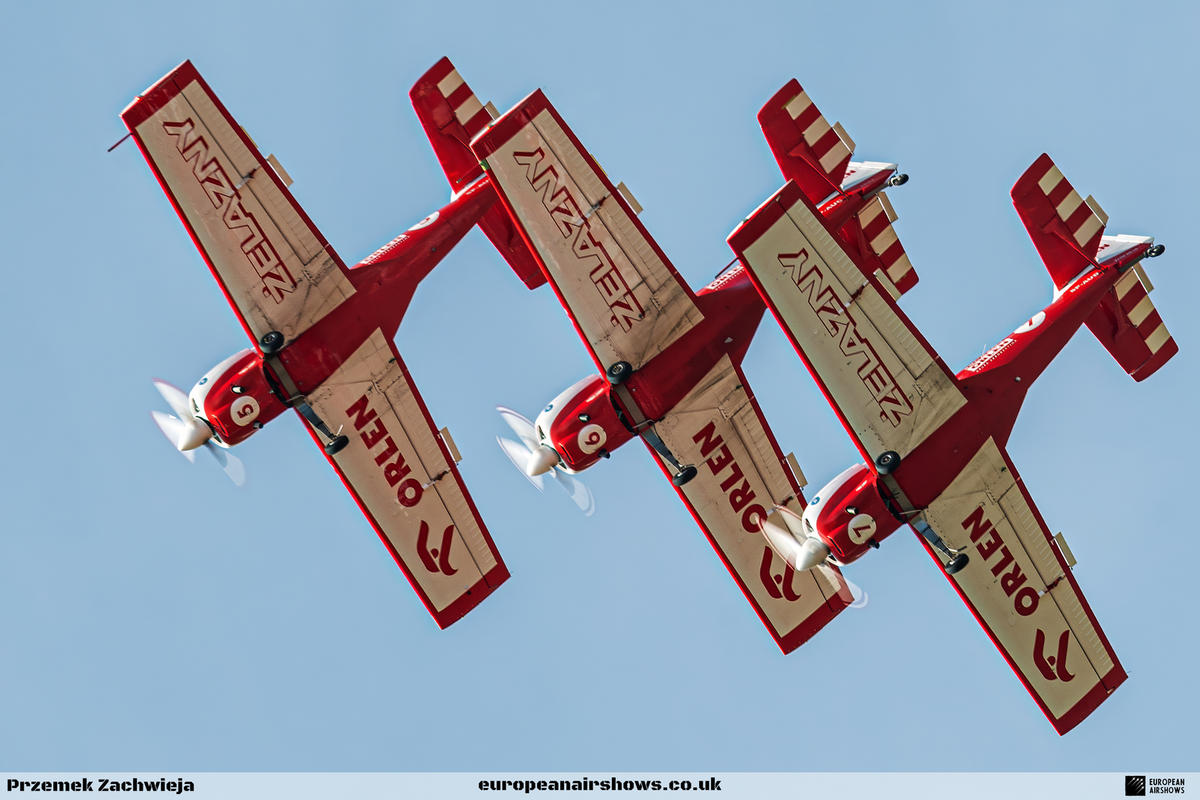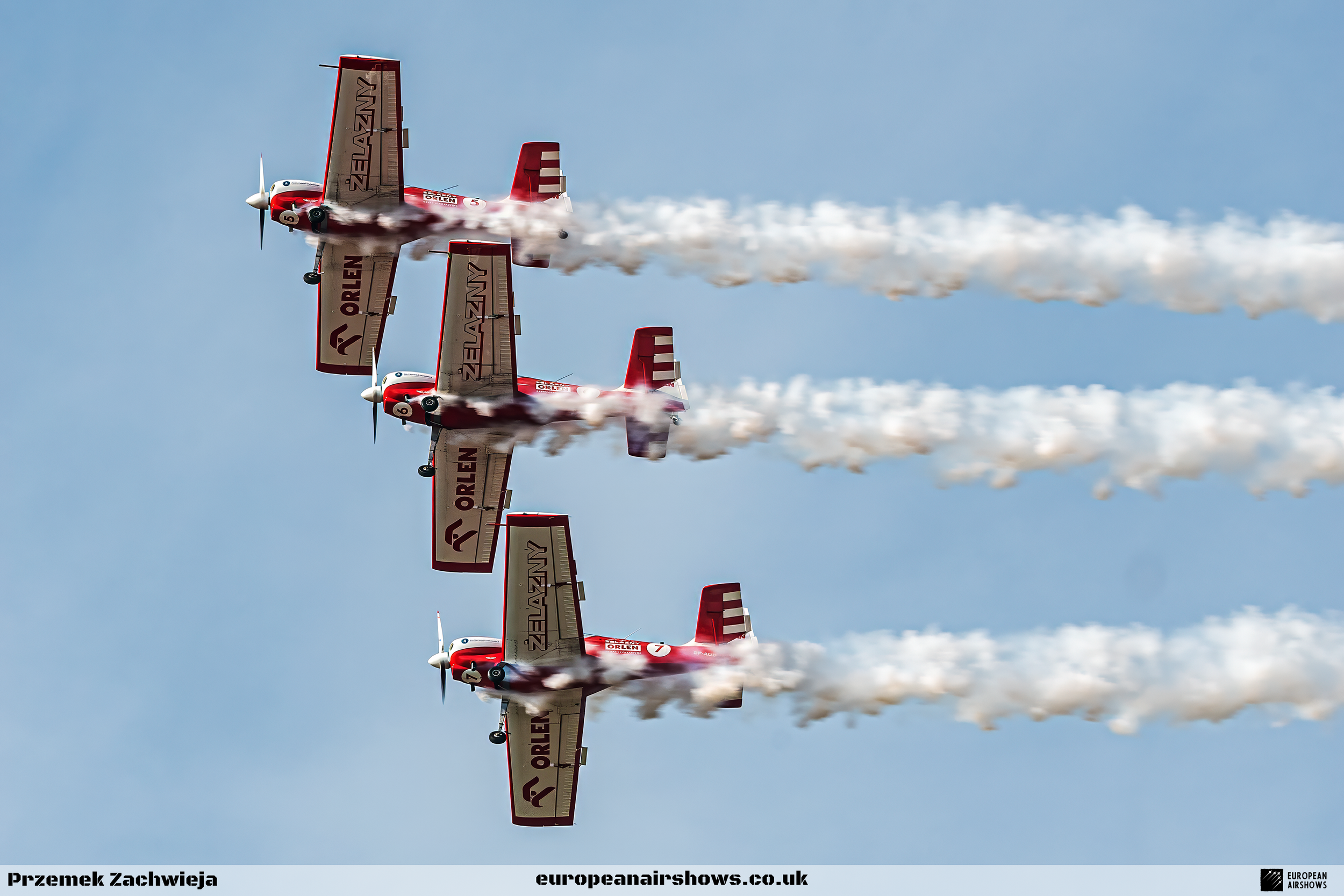
Aerobatic Team Zelazny
About the Team
Grupa Akrobacyjna Żelazny (English: Zelazny Aerobatic Group) is a prestigious civilian aerobatic team based in Kakolewo airfield, Poland. Renowned for their skillful and adaptable performances, the group operates a diverse fleet of aerobatic aircraft, including various models of the Zlin Z-50, Zlin Z-246, and the advanced Extra 330LC. While the team typically performs with three aircraft, they have the capability to adapt to formations ranging from two to six planes, although six-aircraft displays have not been featured in recent years.
Beyond their impressive airshow exhibitions, Grupa Akrobacyjna Żelazny is committed to aviation education and pilot training. They offer comprehensive programs that include training for recovering from unusual flight situations, as well as basic to advanced flying lessons. Additionally, the group provides specialized coaching in higher levels of aerobatics, encompassing advanced and unlimited maneuvers. In 2023, the team enhanced their aircraft with wingtip pyro firing stations, enabling vibrant colored smoke effects during daytime performances and spectacular fireworks displays at night.
As of 2023, the team maintains a fleet of approximately ten aircraft, ensuring a strong presence in both national and international aerobatic competitions and exhibitions. Their dedication to excellence and innovation has solidified their reputation as one of Poland’s premier aerobatic teams.
Team Overview
Number of Aircraft
2 / 6
Established
1999
Based
Kakolewo airfield
Aircraft Type
Zlin Z-50 / Zlin Z-246 / Extra 330LC
About the Aircraft
The Zelazny Aerobatic Team’s fleet prominently features the Zlín Z-50, Zlín Z-246, and Extra 330LC, each bringing unique characteristics and historical significance to their collective performance capabilities. The Zlín Z-50, developed by Zlín Aircraft in the mid-1970s, serves as the cornerstone of the team’s aerobatic maneuvers. Designed under the leadership of Jan Mikula, the Z-50 is an all-metal, single-seat monoplane powered by a Lycoming AEIO-540 series engine, which ensures robust performance and reliability. Its exceptional roll rate is facilitated by full-span ailerons, allowing for precise and rapid directional changes essential in high-stakes competitions. The Z-50 has evolved through various iterations, including the enhanced Z-50LS and the specialized Z-50LX, which incorporate more powerful engines and additional systems for extended performances and airshow routines. Currently, the Polish Aerobatic Team Zelazny operates three Z-50LS aircraft, leveraging their superior handling and durability in international arenas.
Complementing the Z-50, the Zlín Z-246 is a derivative of the esteemed Z-26 Trener series, which has roots dating back to the post-World War II era. The Z-26 was initially designed as a basic training aircraft but evolved into versatile aerobatic variants known as the Akrobat. The Z-246 builds upon this legacy with advancements in all-metal construction and enhanced aerodynamic features, making it well-suited for the rigorous demands of modern aerobatic competition. Although specific technical details of the Z-246 are less extensively documented, its design inherits the robust structure and maneuverability of the Z-26 lineage, ensuring it can perform complex aerial routines while maintaining structural integrity. This adaptability makes the Z-246 an invaluable asset for both training new pilots and executing sophisticated performances, thereby reinforcing the team’s overall performance repertoire.
The Extra 330LC, manufactured by the German company Extra Flugzeugbau, introduces a contemporary high-performance dimension to the Zelazny Aerobatic Team’s lineup. As a product of Walter Extra’s design prowess, the Extra 330LC is a single-seat monoplane engineered for unlimited category competition. It features a welded steel tube fuselage covered with aluminum and fabric, paired with a carbon fiber composite wing spar that offers both strength and lightweight characteristics. Powered by a fuel-injected Lycoming AEIO-580 engine producing 300 horsepower, the Extra 330LC is capable of enduring ±10 Gs, facilitating intricate and high-intensity maneuvers essential for elite aerobatic displays. Its symmetrical airfoil and zero angle of incidence ensure balanced performance in both upright and inverted flight, making it an ideal complement to the Z-50 and Z-246 within the team’s diverse fleet.
Team History
Establishment and Early Years (1999–2002)Grupa Akrobacyjna Żelazny was founded in December 1999 by Andrzej Kraszewski, vice-chairman of Aeroklub Ziemi Lubuskiej (Flying Club of Lubuski Land), with support from the club’s chairman, Lech Marchelewski. The initiative aimed to establish an aerobatic team sponsored by the newly forming Zelazny iron shop network. By May 2000, Aeroklub Ziemi Lubuskiej (AZL) and the Zelazny Company formalized their cooperation, providing the team with its initial aircraft: two Zlin Z-526AFS and one Zlin Z-50LA.
In June 2000, the team began selecting and training additional pilots. During their first year, four pilots were trained—two qualified for higher aerobatics and two for medium aerobatics. Shortly after their formation, the pilots competed in both the Polish Aerobatic Championship and the World Aerobatic Championship, quickly establishing the group’s competitive presence.
To promote aerobatic aviation and nurture new talent, AZL and the Zelazny shop network organized the “Grape Picking” Aerobatic Championship. This event, designed for young and beginner pilots, became an annual fixture in Poland’s airshow and championship calendar.
Expansion and Challenges (2001–2007)The year 2001 marked significant growth for the team with the addition of a Zlin Z-526F, expanding their fleet to four aircraft. The team began performing internationally, including appearances in Germany, and continuously developed their display sequences. Their participation in the international aviation picnic in Goraszka showcased their capabilities in a four-ship formation, attracting more airshow invitations than anticipated.
In 2002, the team systematized their display routines, maintaining a consistent sequence throughout the season. However, the loss of their primary sponsor, the Zelazny iron shop network, posed financial challenges. Consequently, Aeroklub Ziemi Lubuskiej took over all maintenance costs. Despite this setback, the team retained the Zelazny name due to its established reputation both in Poland and internationally.
2003 was a pivotal year for Grupa Akrobacyjna Żelazny. The team was repeatedly invited to perform at the Goraszka International Air Picnic, highlighting their growing acclaim. During this event, the group executed a historic maneuver involving three aircraft connected by four-meter ropes, performing dives, climbs, loops, and landings without detaching the ropes. This display mirrored a performance last executed by the “Trojka Bajana” (The Bajan’s Three) in the 1930s, garnering extensive media attention.
Tragically, two weeks later, a training accident resulted in the deaths of two wingmen while practicing an engine failure landing procedure. In response, the team decided to continue operations, training two new pilots and reducing their formation to three aircraft. Despite the loss, Wojciech Krupa and Krzysztof Kossinski secured a bronze medal at the European Aerobatic Championship in Sweden, and Krupa also won gold at the Polish Aerobatic Championship, demonstrating the team’s resilience and competitive spirit.
In 2004, the team aimed to restore their four-aircraft formation. Lech Marchelewski took over as formation leader, joined by Wojciech Krupa (left wingman), Tadeusz Kolaszewski (right wingman), and Krzysztof Kossinski (slot and solo pilot). The display sequence was revamped to align with the team’s current capabilities. Throughout the year, the team participated in numerous airshows across Poland, as well as events in Germany and the Czech Republic.
Continued Growth and Tragedy (2005–2007)Piotr Haberland joined the team in 2005, bringing additional expertise and strengthening the group’s lineup. Under his membership, the team achieved notable placements in the European and World Advanced Aerobatic Championships. The 2007 season was particularly successful, with the team securing the 18th place in the European Advanced Aerobatic Championship held in Finland. Additionally, the group began training for six-aircraft formations, planning a significant showcase at the Radom Air Show—the largest airshow in Poland.
However, on September 1, 2007, during their first official six-aircraft display at the Radom Air Show, a tragic accident occurred. During the “rose” maneuver, planes #1 and #2 collided mid-air, resulting in the deaths of team leader Lech Marchelewski and pilot Piotr Banachowicz. The incident profoundly impacted the team, leading to a temporary reduction in their formation and a period of mourning. Despite the tragedy, the team demonstrated remarkable resilience by resuming performances three weeks later, with Wojciech Krupa assuming leadership and restructuring the formation to three aircraft for the 2008 season.
Rebuilding and International Expansion (2008–Present)In 2008, Grupa Akrobacyjna Żelazny rebranded to include support from both Aeroklub Ziemi Lubuskiej and Poznan Flying Club, enhancing their resources and training capabilities. The team made history by performing at the Sacheon Aerospace Expo in South Korea, becoming the first Polish aerobatic team to showcase in Asia. This year also saw the establishment of the “Zelazny 6” Flying School, one of Poland’s few facilities offering higher-level aerobatic training.
By 2009, the team introduced the Extra-330LC aircraft, branded as “Zelazna Extra,” enhancing their performance capabilities. They continued to excel in national competitions, achieving top placements in the Polish Aerobatic Championships. In March 2009, team members Wojciech Krupa and Piotr Haberland were selected for the Polish National Flying Club Management, underscoring their leadership within the aviation community.
On January 16, 2020, Grupa Akrobacyjna Żelazny entered a significant sponsorship agreement with Orlen, a major oil industry corporation in Central and Eastern Europe. This partnership included a complete repainting of their aircraft and continued until the end of 2024.
In 2023, the team further enhanced their performances by installing wingtip pyro firing stations on select aircraft, enabling visually striking smoke effects during daytime shows and spectacular fireworks displays at night.
Today, Grupa Akrobacyjna Żelazny maintains a robust fleet of approximately ten aircraft, including the latest Extra 330LC, and continues to perform at airshows and competitions both in Poland and internationally. The team remains committed to fostering the next generation of aerobatic pilots through their comprehensive training programs, solidifying their status as one of Poland’s premier aerobatic teams.
Did You Know?
- The Zelazny Aerobatic Team was founded in December 1999 through a collaboration between the Aeroklub Ziemi Lubuskiej and the Zelazny iron shop network, which was intended to sponsor the team.
- Although primarily a trainer, the Gnat gained fame in the United Kingdom as the aircraft used by the Royal Air Force’s prestigious Red Arrows aerobatic team until it was succeeded by the Hawker Siddeley Hawk.
- In 2003, during the Goraszka International Air Picnic, the Zelazny team performed a unique maneuver involving three planes connected by 4-meter ropes, a feat not accomplished in Poland for 70 years until it was replicated by the team.
- The Zelazny Aerobatic Team was the first Polish aerobatic team to perform in Asia, showcasing their skills at the Sacheon Aerospace Expo in South Korea in 2008.
- The Zelazny Aerobatic Team operates one of the few pilot training facilities in Poland, known as the “Zelazny 6” Flying School, which offers training up to the higher level of aerobatics.
Test Your Knowledge
1. When was the Zelazny Aerobatic Team founded?
















